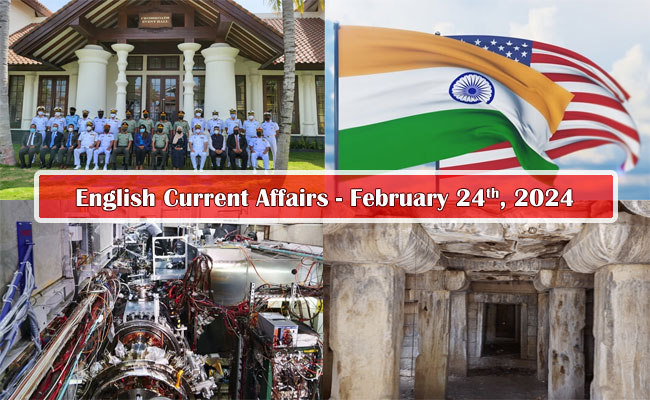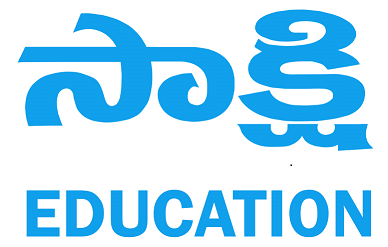24th February, 2024 Current Affairs
Sakshi Education

NATIONAL
Exercise Dosti began
- Indian and Sri Lankan coast guard ships reached the Maldives recently to take part in the trilateral coast guard exercise Dosti 16.
- It is a trilateral coast guard exercise between India, Sri Lanka, and the Maldives.
- It is a biennial exercise.
- It was first conducted in 1991 between the Indian and Maldives Coast Guards.
- Sri Lanka joined the exercise for the first time in 2012. Dosti was last conducted in 2021.
- The exercises have focused on exercises and drills on providing assistance in sea accidents, eliminating sea pollution, and the coast guard’s procedures and conduct during situations such as oil spills.
- The aim of the exercise is to further fortify the friendship, enhance mutual operational capability, exercise interoperability and build cooperation between the Coast Guards of India, Sri Lanka, and the Maldives.
INTERNATIONAL
India and US hold bilateral Consular Dialogue in New Delhi
- India and US have discussed ways of enhancing cooperation on a wide range of issues such as extradition, mobility of students and professionals, safe and legal migration, protection of vulnerable women and children and enabling smooth travel of their respective nationals.
- The 11th bilateral Consular Dialogue between India and the US took place in New Delhi yesterday. The Indian delegation led by Joint Secretary in the Ministry of External Affairs, Dr. K J Srinivasa hosted the US delegation led by Assistant Secretary in Bureau of Consular Affairs, US Department of State, Ambassador Rena Bitter.
- The Dialogue reinforced the strong people-to-people ties and cooperation that both countries share across consular issues of mutual interest. Both sides welcomed the launch of a pilot in the US to adjudicate domestic renewals of certain categories of visas as proactive steps toward strengthening robust connections between people of the two countries. Both sides agreed to hold the next Consular Dialogue in the US next year.
>> Download Current Affairs PDFs Here
Download Sakshi Education Mobile APP

SCIENCE AND TECHNOLOGY
Anti-hydrogen Experiment: Gravity, Interferometry, Spectroscopy (AEgIS)
- In a first, an international team of physicists from the Anti-hydrogen Experiment: Gravity, Interferometry, Spectroscopy (AEgIS) collaboration has achieved a breakthrough by demonstrating the laser cooling of Positronium.
- It is an experiment approved by CERN (European Organization for Nuclear Research) with the goal of studying antihydrogen physics.
- The primary goal of AEgIS is the direct measurement of the Earth's gravitational acceleration, g, on antihydrogen.
- Once performed this could be the first direct test of the gravitational interaction between matter and antimatter.
- AEgIS is a collaboration of physicists from a number of countries in Europe and from India.
- Antimatter is the same as ordinary matter except that it has the opposite electric charge.
- It is also known as “mirror” matter.
- For instance, an electron, which has a negative charge, has an antimatter partner known as a positron. A positron is a particle with the same mass as an electron but a positive charge.
- The antimatter particles corresponding to electrons, protons, and neutrons are called positrons, antiprotons, and antineutrons; collectively they are referred to as antiparticles.
- These anti-particles can combine to form anti-atoms and, in principle, could even form anti-matter regions of our universe.
- Matter and antimatter cannot coexist at close range for more than a small fraction of a second because they collide with and annihilate each other, releasing large quantities of energy in the form of gamma rays or elementary particles.
- Antimatter was created along with matter after the Big Bang.
ART AND CULTURE
Two Badami Chalukya temples were discovered in Mudimanikyam village along the banks of Krishna
- Two Badami Chalukya temples at least 1,300-1,500 years old and a 1,200-year-old label inscription were recently discovered in Mudimanikyam village along the banks of Krishna.
- The Chalukyas ruled over the central Indian plateau of the Deccan between the sixth and twelfth centuries.
- During that period, they ruled as three closely related but individual dynasties.
- The Chalukyas of Badami, who ruled between the sixth and the eighth centuries, and the two sibling dynasties of the Chalukyas of Kalyani, or the Western Chalukyas, and the Chalukyas of Vengi, or the Eastern Chalukyas.
- Pulakesi I established the Chalukya dynasty in 550.
- Pulakesi I took Vatapi (Badami in Bagalkot district, Karnataka) under his control and made it his capital.
- Historians refer to Pulakesi I and his descendants as the Chalukyas of Badami.
- They ruled over an empire that comprised the entire state of Karnataka and most of Andhra Pradesh in the Deccan.
- Pulakesi II had been perhaps the greatest emperor of the Badami Chalukyas.
- Pulakesi II extended the Chalukya Empire up to the northern extents of the Pallava kingdom and halted the southward march of Harsha by defeating him on the banks of the river Narmada.
- He then defeated the Vishnukundins in the southeastern Deccan.
- Pallava Narasimhavarman reversed that victory by attacking and occupying the Chalukya capital, Vatapi (Badami).
- Hiuen-Tsiang, a Chinese traveller, had visited the court of Pulakesi II.
- Later, Persian emperor Khosrau II exchanged ambassadors with Pulakesi II.
Published date : 24 Feb 2024 05:55PM




















